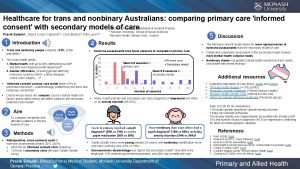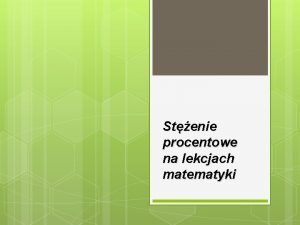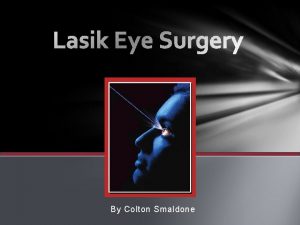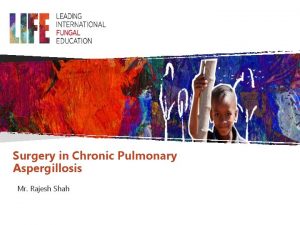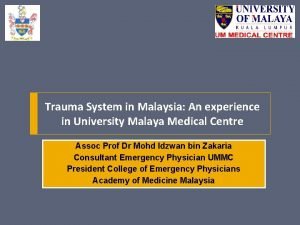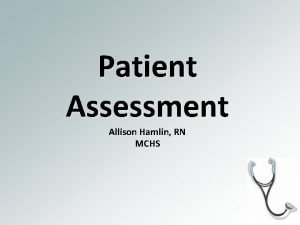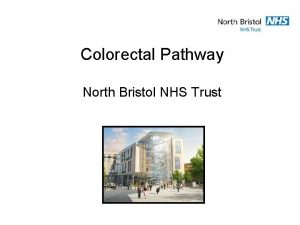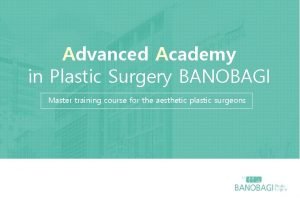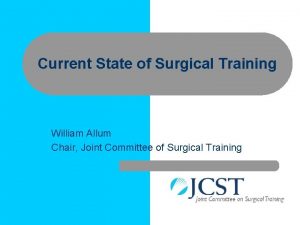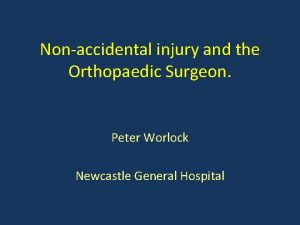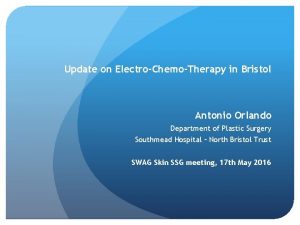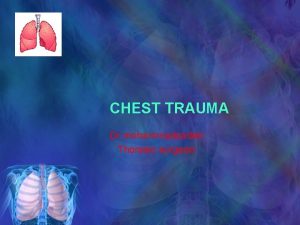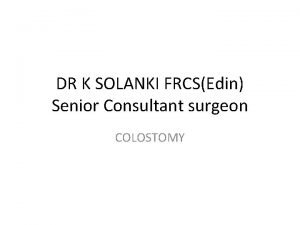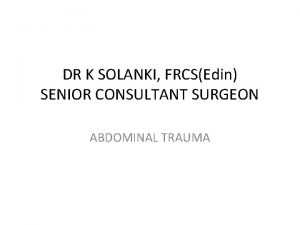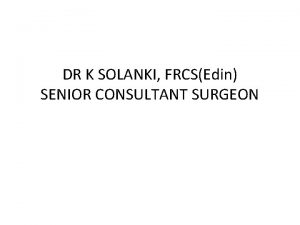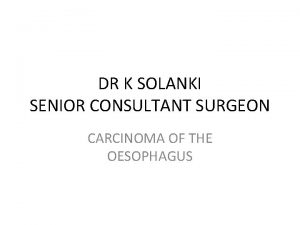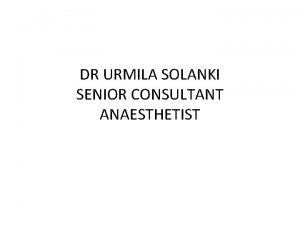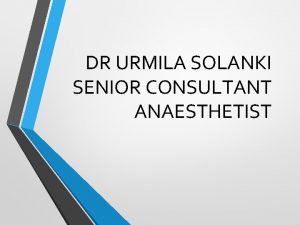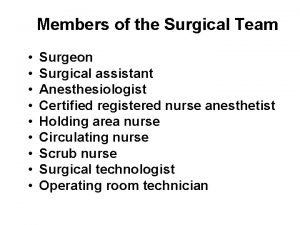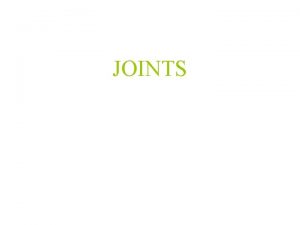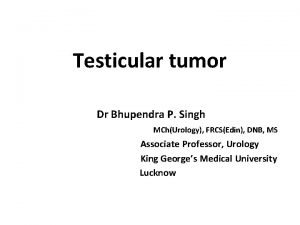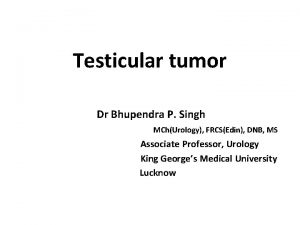DR K SOLANKI FRCSEdin Senior Consultant surgeon SURGICAL

















- Slides: 17

DR K SOLANKI FRCS(Edin) Senior Consultant surgeon

SURGICAL NUTRITION • INTRODUCTION: • Malnutrition is common • It occurs in about 30% of surgical patients with GI disease. • 60% of those in whom hospitalization is prolonged due to post-op complications. • AIM of nutritional support – identify those patients at risk and to ensure that their nutritional requirements are met by the most appropriate route and in the way that minimmise complications.

(a) Metabolic response to starvation (b) Metabolic response to trauma, sepsis NUTRITIONAL ASSESSMENT: Simple way is to estimate weight loss: Body mass index (BMI): Body weight in Kg / height in meters square. BMI less than 18. 5 – nutritional impairment BMI less than 15 - Associated with significant hospital mortality. ANTHROPOMETRY TECHNIUE: Measurements of skinfold thickness & Measurement of arm circumference permit estimation of body fat and muscle mass (indirect measurements of energy and protein stores.

• MACRONUTRIENT REQUIREMENTS: • Majority of hospitalised patients, total energy requirements are 1300 to 1800 Kcal/day. • A. CARBOHYDRATE: • There is obligatory glucose requirement to meet needs of – central nervous system & certain haemopoetic cells.

• B. FATS: • Unsaturated fatty acids linoleic and linolenic acid are considered essential because they are synthesized in vivo from non-dietary source. • Soybean and sunflower oil emulsions are rich source of linoleic acid. • Provision of 1 liter of emulsion per week avoids deficiency.

• Safe and non-toxic emulsions based upon long chain triglycerides (LCTs) are available. • Energy during parenteral nutrition should be given as mixture of fat together with glucose. • Basal requirement for glucose – 100 -200 Gm/day and for fatty acids 100 -200 Gm/week. • Concern about immuno-suppressive effect of long chain (LCT) emulsions – newer emulsions of medium chain triglycerides – omega-3 fatty acids (combination of long- and medium-chain triglycerides in the same emulsion.

• C. PROTEIN: • Basic requirement in patients without pre-existing malnutrition and without metabolic stress is 0. 10 -0. 15 g/kg/day. • In hypermetabolic patients the nitrogen requirement increases to 0. 20 -0. 25 g/kg/day • D. VITAMINS, MINERALS & TRACE ELEMENTS: • The water soluble vitamins B and C act as coenzymes in collagen formation and wound healing. • Post-operatively, Vit. C requirement increases to 60 -80 mg/day. • Supplemental vit. B 12 indicated in patients who have undergone intestinal resection and gastric surgery

• Absorption of fat-soluble vitamins A, D, E & K • Is reduced in steatorrhea and absence of bile. • Sodium, potassium and phosphate are all subjective to significant losses – diarrhoea. • Trace elements act as cofactors for metabolic processes. Magnesium, zinc and iron levels decrease as part of the inflammatory response. • Supplementation to optimise the utilisation of amino acids and to avoid re-feeding syndrome.

• SHORT BOWEL SYNDROME: • More than 200 cm of small bowel resected together with colostomy. • ARTIFICIAL NUTRITIONAL SUPPORT: • Indication: - Any patient with 5 -7 days of inadequate intake, or no intake. • ENTERAL NUTRITION: • Means delivery of nutrients into the GI tract.

• (a) Oral supplement: • Sip feeding: One cartoon will contain 200 k. cal and 2 gm nitrogen per 200 ml cartoon. • (b) Tube-feeding: varieties – to stomach, duodenum, jejunum. • (i) Nasogastric tube (Ryle’s) • (ii) Feeding gastrostomy • (iii) Jejunostomy

Conventionally, 20 -30 c. c. administered per hour initially, then gradually increasing to goal rates within 48 -72 hours. • Feeding s discontinued for 4 -5 hours overnight to allow gastric p. H to return to normal. • PARENTERAL NUTRITION: • Total parenteral nutrition (TPN): • Provision of all nutrition al requirements by IV route and without the use of the gastrointestinal tract. Indication: When energy and protein needs cannot be met by enteral administration. ★ Massive resection of small bowel ★ Intestinal fistula ★ Prolonged intestinal failure •

• Route: • 1. Peripheral: • For short term feeding of up to 2 weeks, by using cannula in peripheral veins. • Advantage: Avoids complications associated with central venous administration. • Disadvantage: Development of thrombophlebitis.

• 2. Central: • The catheter can be inserted via subclavian or internal or external jugular vein. (safest means by insertion of lines under ultrasound guidance. • Complications of parenteral nutrition: • A. Related to nutrient deficiency. Hypoglycaemia/hypocalcaemia/hypophosphataemia/hyp omagnesaemia(refeeding syndrome). Chronic deficiency syndromes (essential fatty acids, zinc, mineral and trace elements)

• B. Related to overfeeding: • Excess glucose: hyperglycaemia, hyperosmolar dehydration, hepatic steatosis, hypercapnia, increased sympathetic activity, fluid retension, electrolyte abnormalities. • Excess fat: hypercholesterolaemia, hyper triglyceridaemia, hypersensitivity reactions. • Excess amino acids: hyperchloraemic metabo; ic acidosis, hypercalcaemia, aminoacidaemia, uraemia.

• C. Related to sepsis: • Catheter related sepsis • Possible increased predisposition to systemic sepsis. • D. Related to line: • On insertion: pneumothorax, damage to adjacent artery, air embolism, thoracic duct damage, cardiac perforation or tamponade, pleural effusion, hydromediastinum. • Long-term use: Occlusion, venous thrombosis.

• Refeeding syndrome: • Characterized by severe fluid and electrolyte shifts in malnourished patients undergoing refeeding. It can occur with either enteral or parenteral nutrition but is more common with parenteral. • It results in hypophosphataemia, hypocalcaemia, and hypomagnesaemia. These electrolyte disorders can result in altered myocardial function, arrhythmias, deteriorating respiratory function, liver dysfunction, seizures, confusion, coma, tetany and death.

• Treatment: • Match intakes with requirements and avoiding overfeeding. • Caloric delivery should be increased slowly and vitamins administered regularly. • Hypophosphataemia and hypomagnesaemia require treatment.
 Wzor na cp
Wzor na cp Pravik solanki
Pravik solanki Wzór na stężenie procentowe
Wzór na stężenie procentowe Lasik surgeon colton
Lasik surgeon colton Civil surgeon worksheet
Civil surgeon worksheet Rajesh shah thoracic surgeon
Rajesh shah thoracic surgeon Trauma surgeon malaysia
Trauma surgeon malaysia Allison hamlin
Allison hamlin Origin of the word surgery
Origin of the word surgery Ann lyons colorectal surgeon
Ann lyons colorectal surgeon Dr lee banobagi review
Dr lee banobagi review Thorasic surgeon
Thorasic surgeon William allum surgeon
William allum surgeon Cluster surgeon
Cluster surgeon Peter worlock
Peter worlock Stephen brennan bon secours
Stephen brennan bon secours Antonio orlando
Antonio orlando Thorasic surgeon
Thorasic surgeon

